
Browse an alphabetical list of photographs. These historical images portray people, places, and events before, during, and after World War II and the Holocaust.
<< Previous | Displaying results 2201-2250 of 2641 for "Photo" | Next >>
At left, a column of Soviet prisoners of war, under German guard, marches away from the front. Place uncertain, July 1, 1941.
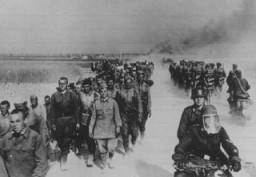
Soviet prisoners of war wait for food in Stalag (prison camp) 8C. More than 3 million Soviet soldiers died in German custody, mostly from malnutrition and exposure. Zagan, Poland, February 1942. Second only to the Jews, Soviet prisoners of war were the largest group of victims of Nazi racial policy.
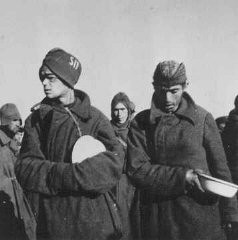
Soviet soldiers guard the entrance to Adolf Hitler's underground bunker. Upon the advance of Soviet forces through the streets of Berlin, Hitler committed suicide here on April 30, 1945, rather than face capture. Berlin, Germany, 1945.
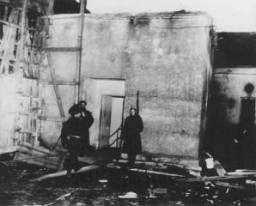
Soviet soldiers in a street in the Soviet occupation zone of Berlin following the defeat of Germany. Berlin, Germany, after May 9, 1945.
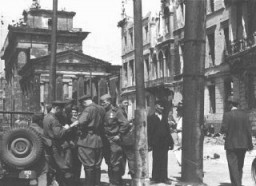
Soviet soldiers in a street in the Soviet occupation zone of Berlin following the defeat of Germany. Berlin, Germany, after May 7, 1945.
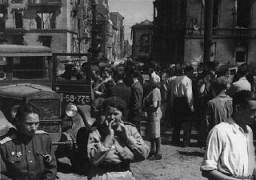
Soviet soldiers in the Soviet occupation zone of Berlin following the defeat of Nazi Germany. Berlin, Germany, after May 9, 1945.
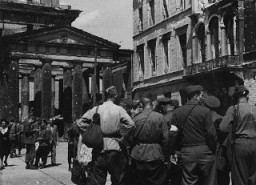
Soviet soldiers inspect a box containing poison used in medical experiments. Auschwitz, Poland, after January 27, 1945.
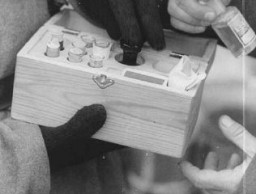
Soviet tanks roll down a street in Vienna during the Soviet conquest of the Austrian capital at the end of World War II. Photograph taken by Yevgeny Khaldei. Vienna, Austria, 1945.
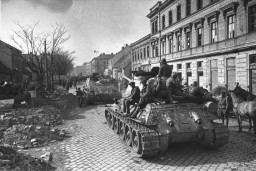
Soviet troops trample a Nazi flag as they march past a burning house on a street in the outskirts of Vienna. Photograph taken by Soviet photographer Yevgeny Khaldei. Vienna, Austria, April 1945.
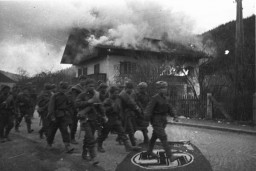
Cheering spectators greet Hitler upon his departure for the Reichstag session at which the Enabling Act was passed. The act allowed the government to issue laws without the consent of Germany’s parliament, laying the foundation for the complete Nazification of German society.
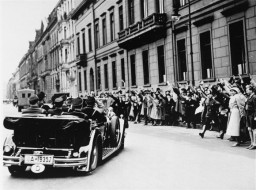
In the Olympic Stadium, German spectators salute Adolf Hitler during the Games of the 11th Olympiad. Berlin, Germany, August 1936.
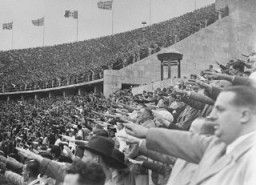
The Nazis used public displays to spread their ideas of race. The chart shown here is titled "The Biology of Growth," and is labeled "Stages of Growth for Members of the Nordic Race."
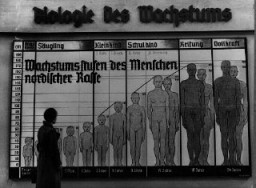
SS and Nazi police prepare for a raid on the Jewish community offices in Vienna. Austria, March 18, 1938.
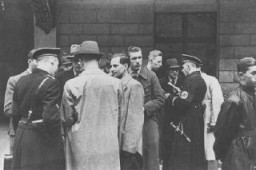
SS and Police Leader Juergen Stroop interrogates two Jews arrested during the Warsaw ghetto uprising. Poland, April 19-May 16, 1943.
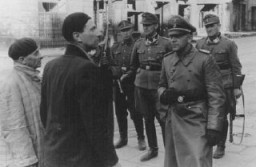
SS chief Heinrich Himmler addresses a group of soldiers in a cavalry regiment of the Waffen SS in the eastern territories. 1942.
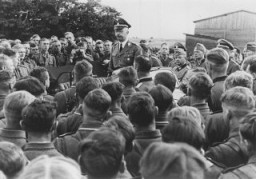
SS chief Heinrich Himmler (right) during a visit to the Auschwitz camp. Poland, July 18, 1942.
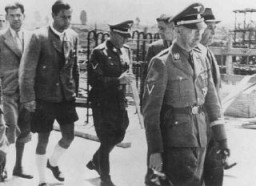
An official visit of Heinrich Himmler to the Lodz ghetto. Mordechai Chaim Rumkowski, head of the Jewish council, greets the Nazi officials. Lodz, Poland, June 5, 1941.
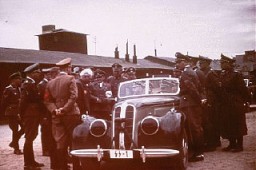
SS Colonel Franz Ziereis, commandant of the Mauthausen concentration camp in Austria.
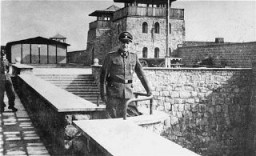
SS female auxiliaries show with mock sadness that they have finished eating their blueberries, July 22, 1944. From the Hoecker Album of 116 photographs taken during the last six months of Auschwitz, between June 1944 and January 1945.
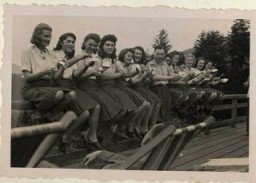
SS female auxiliaries (Helferinnen) run down a ramp in Solahütte to the music of an accordion. From Karl Höcker's photograph album, which includes both documentation of official visits and ceremonies at Auschwitz as well as more personal photographs depicting the many social activities that he and other members of the Auschwitz camp staff enjoyed. These rare images show Nazis singing, hunting, and even trimming a Christmas tree. They provide a chilling contrast to the photographs of thousands of…

SS General Reinhard Heydrich in his office during his tenure as Bavarian police chief. Munich, Germany, April 11, 1934.
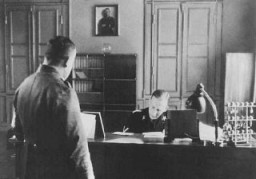
SS men search through massive piles of clothing belonging to the more than 33,000 Jews murdered at the nearby Babyn Yar killing site. The SS forced the victims to undress and leave their belongings behind. The Jews were then marched or driven to the shooting site. Kyiv (Kiev), German-occupied Soviet Union, after September 30, 1941.
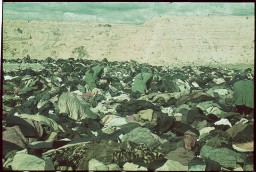
Headquarters of the SS chief at 9 Prince Albert Street. Berlin, Germany, date uncertain.
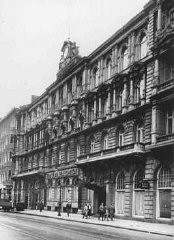
SS Lieutenant Colonel Arthur Roedl, commandant of the Gross-Rosen concentration camp. Gross-Rosen, Germany, between May 1, 1941, and September 15, 1942.
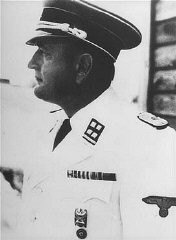
SS men guard Soviet prisoners of war doing forced labor near the Babyn Yar killing site. The photograph was taken within days of the mass murder of over 33,000 Jews on September 29-30, 1941. Kyiv (Kiev), German-occupied Soviet Union, after September 30, 1941.
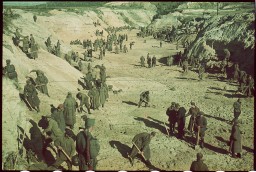
SS men or German police officers on one of the sandy cliffs near the Babyn Yar killing site. Below them are unidentified men, perhaps Soviet prisoners of war or local Ukrainians, who sorted through the huge piles of clothing belonging to the more than 33,000 Jews from Kyiv (Kiev) who were murdered at Babyn Yar. Kyiv, German-occupied Soviet Union, after September 30, 1941.
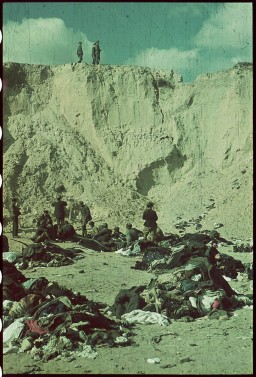
Scene during a visit by SS officer Theodor Eicke to the Lichtenburg camp in March 1936. Lichtenburg was one of the first concentration camps established in Germany were established soon after Hitler's appointment as chancellor in January 1933. When SS chief leader Heinrich Himmler centralized the administration of the concentration camps and formalized the camp system, he chose SS Lieutenant General Theodor Eicke for the task. Himmler appointed him Inspector of Concentration Camps, a new section of the…
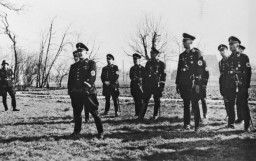
SS officers and German nurses gather during the dedication ceremony of the new SS hospital in Auschwitz, September 1, 1944. Among those pictured are Karl Höcker, Josef Kramer, and SS-Hauptsturmführer Heinrich Schwarz.
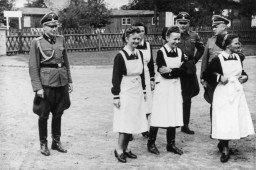
Three SS officers at the Breendonk internment camp: from left, First Lieutenant Hans Kantschuster, Master Sergeant Walter Mueller, and Second Lieutenant Artur Prauss. Breendonk, Belgium, between 1940 and 1944.
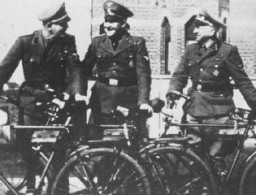
This photograph shows a group of SS officers at Solahütte, the SS retreat outside of Auschwitz. Pictured from left to right: Richard Baer, Dr. Josef Mengele, and Rudolf Höss. From Karl Höcker's photograph album, which includes both documentation of official visits and ceremonies at Auschwitz as well as more personal photographs depicting the many social activities that he and other members of the Auschwitz camp staff enjoyed. These rare images show Nazis singing, hunting, and even trimming a Christmas…
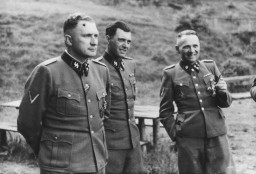
Rare photograph showing Sobibor killing center personnel relaxing and posing, all while implementing the mass murder of at least 167,000 innocent Jews.
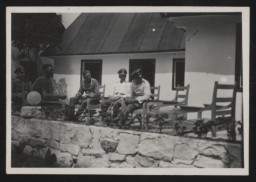
Polish women from the Pawiak and Mokotow prisons in nearby Warsaw are led into the Palmiry forest for execution by SS personnel.The original caption reads: "Their Nazi executioners leading a group of Polish women, according to the information attached to this picture which was just received through Polish sources. Hundreds of cvilians, men, women and even young children are said to be systematically 'eliminated' under the Nazi scheme of things in war-torn Poland". Palmiry Forest, Poland,…
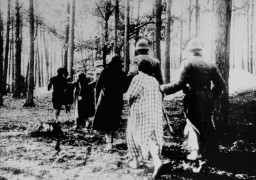
A "sing-along" during a social gathering of the SS hierarchy at Solahütte. The front row consists of (left to right): Karl Höcker, Otto Moll, Rudolf Höss, Richard Baer, Josef Kramer, Franz Hössler, and Josef Mengele. From Höcker's album.
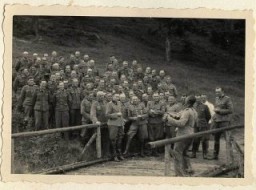
On the day of the vote on the so-called Enabling Act, the Nazi leadership sent SS troops into the makeshift Reichstag building, formerly the Kroll Opera, to intimidate other political parties. Berlin, Germany, March 23, 1933. The Enabling Act allowed the Reich government to issue laws without the consent of Germany’s parliament, laying the foundation for the complete Nazification of German society. The full name of the law was the “Law to Remedy the Distress of the People and the Reich.”
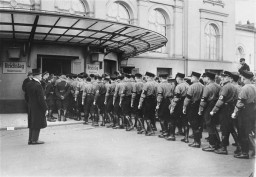
SS troops lead a group of Poles into the forest near Witaniow for execution. Witaniow, Poland, October–November 1939.

SS troops stand at attention for inspection, Germany, 1936-1939. This photo is from an album of SS photographs.
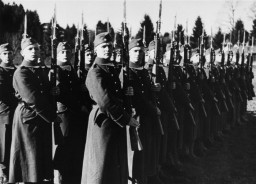
The St. Louis, carrying Jewish refugees from Nazi Germany, arrives in the port of Antwerp after Cuba and the United States denied it landing. Belgium, June 17, 1939.
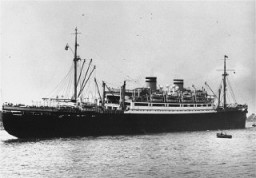
Boarding pass for Dr. Walter Weissler for a voyage on the St. Louis from Hamburg to Havana. When Cuban authorities refused the passengers entry, Weissler returned to France, where he survived in hiding. He died in Paris in 1996. Hamburg, Germany. Date of pass, May 13, 1939.

Passengers on the St. Louis wait to hear whether the Cuban government will permit them to land. Havana, Cuba, between May 27 and June 2, 1939.

Soviet officials view stacked corpses of victims at the Klooga camp. Due to the rapid advance of Soviet forces, the Germans did not have time to burn the corpses. Klooga, Estonia, 1944.
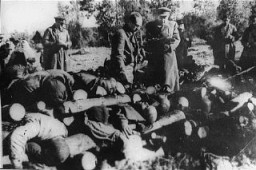
Staff from the Hadamar euthanasia center, including senior physician Adolf Wahlmann (front, left), during their trial. Wiesbaden, Germany, October 8-15, 1945.
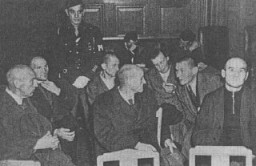
Stateless Jewish refugees at the Mischdorf tent camp along the Slovak-Hungarian border, following the First Vienna Award which gave a sector of southern Slovakia to Hungary. Local Jews were accused of supporting the Hungarian claim, were driven across the border, then back again, then were forced to live for weeks in an open field. November 1938.
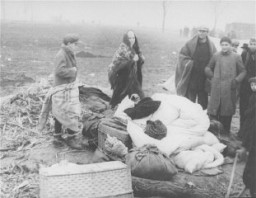
Stephen S. Wise, later to become president of the World Jewish Congress, speaks at an anti-Nazi rally at Madison Square Garden. New York, United States, March 27, 1933.
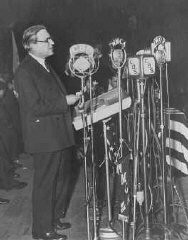
American Zionist leader Rabbi Stephen S. Wise (right) with Bernard Deutsch, president of the American Jewish Congress, before making a protest to President Franklin D. Roosevelt against religious persecution in Germany. New York, United States, March 22, 1933.
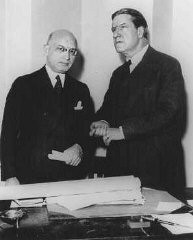
American Jewish Congress president Stephen S. Wise (center right), with Dr. Ignacy Schiper (far left), a Polish Zionist. Warsaw, Poland, 1936.
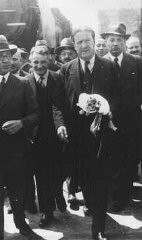
View of the stone quarry in the Gross-Rosen camp, where prisoners were subjected to forced labor. Gross-Rosen, Germany, 1940-1945.
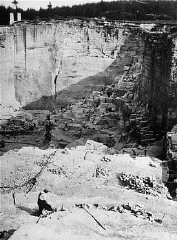
Shortly after the German annexation of Austria, Nazi Storm Troopers stand guard outside a Jewish-owned business. Graffiti painted on the window states: "You Jewish pig may your hands rot off!" Vienna, Austria, March 1938.
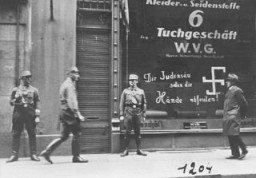
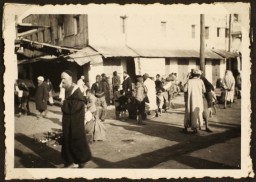
A Jewish family strolls along a street in prewar Kalisz. Poland, May 16, 1935.
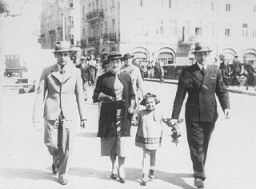
Street scene in the Warsaw ghetto. The sign at left announces: "Soup in the courtyard, first floor, apt. 47." Warsaw, Poland, 1940-1941.
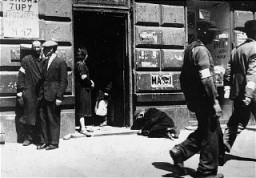
We would like to thank Crown Family Philanthropies, Abe and Ida Cooper Foundation, the Claims Conference, EVZ, and BMF for supporting the ongoing work to create content and resources for the Holocaust Encyclopedia. View the list of donor acknowledgement.